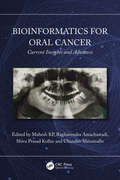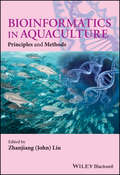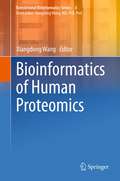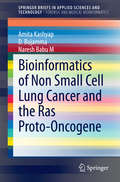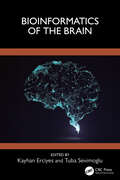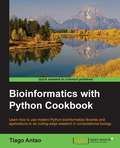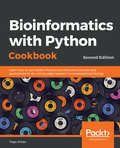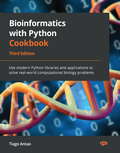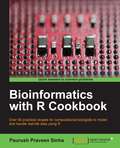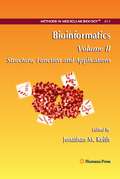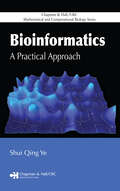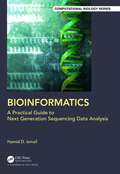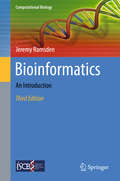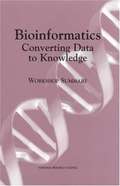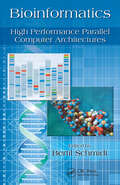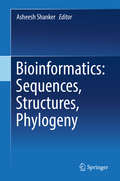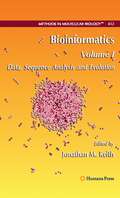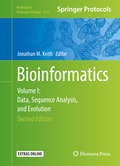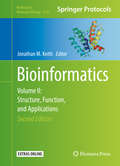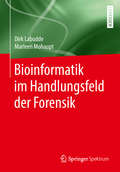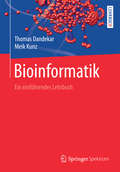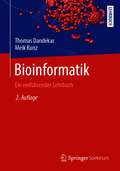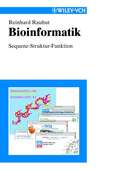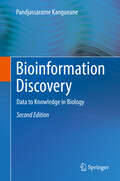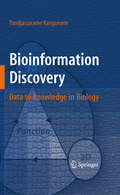- Table View
- List View
Bioinformatics for Oral Cancer: Current Insights and Advances
by Raghavendra Amachawadi Shiva Prasad Kollur Chandan Shivamallu Mahesh KpAmid the rising global concern of oral cancer, this book provides a compelling exploration of the intricate oral cavity, focused on shedding light on early diagnosis and addressing outdated paradigms, it delves into the persistent challenges of oral premalignant lesions. Tailored for both beginners and researchers, its six chapters encompass the spectrum of genome sequencing, diagnostic biomarkers, gene expression, and more. Discover a fusion of basic and clinical sciences, aiming to invigorate the study of bioinformatics and oral cancer, and ultimately improve survival rates.Bioinformatics for Oral Cancer: Current Insights and Advances serves as a comprehensive guide, offering a deep dive into the multifaceted landscape of oral cancer research and bioinformatics. Within its pages, readers will uncover a wealth of knowledge, starting with foundational chapters introducing bioinformatics and establishing the backdrop of oral cancer. The book then progresses into the realm of diagnostic biomarkers, revealing cutting-edge methodologies for their identification in the context of oral cancer. The book’s keen focus extends to gene expression profiles and the intricacies of gene sequencing in the context of oral cancer progression. By systematically unravelling these critical aspects, the book bridges the gap between basic and clinical sciences, equipping readers with a holistic understanding of bioinformatics’ pivotal role in enhancing our grasp of oral cancer’s complexities.By deciphering the enigmatic landscape of oral premalignant lesions, the book equips clinicians and researchers with tools to predict malignant potentials. Its meticulous exploration of gene expression profiles and sequencing promises to reshape early detection strategies, propelling the field towards improved diagnosis and treatment outcomes.
Bioinformatics in Aquaculture: Principles and Methods
by Zhanjiang John LiuBioinformatics derives knowledge from computer analysis of biological data. In particular, genomic and transcriptomic datasets are processed, analysed and, whenever possible, associated with experimental results from various sources, to draw structural, organizational, and functional information relevant to biology. Research in bioinformatics includes method development for storage, retrieval, and analysis of the data. Bioinformatics in Aquaculture provides the most up to date reviews of next generation sequencing technologies, their applications in aquaculture, and principles and methodologies for the analysis of genomic and transcriptomic large datasets using bioinformatic methods, algorithm, and databases. The book is unique in providing guidance for the best software packages suitable for various analysis, providing detailed examples of using bioinformatic software and command lines in the context of real world experiments. This book is a vital tool for all those working in genomics, molecular biology, biochemistry and genetics related to aquaculture, and computational and biological sciences.
Bioinformatics of Human Proteomics (Translational Bioinformatics #3)
by Xiangdong Wang"Bioinformatics of Human Proteomics" discusses the development of methods, techniques and applications in the field of protein bioinformatics, an important direction in bioinformatics. It collects contributions from expert researchers in order to provide a practical guide to this complex field of study. The book covers the protein interaction network, drug discovery and development, the relationship between translational medicine and bioinformatics, and advances in proteomic methods, while also demonstrating important bioinformatics tools and methods available today for protein analysis, interpretation and predication. It is intended for experts or senior researchers in the fields of clinical research-related biostatistics, bioinformatics, computational biology, medicine, statistics, system biology, molecular diagnostics, biomarkers, or drug discovery and development. Dr.Xiangdong Wang works as a distinguished professor of Respiratory Medicine at Fudan University, Shanghai, China. He serves as Director of Biomedical Research Center, Fudan University Zhongshan Hospital and adjunct professor of Clinical Bioinformatics at Lund University, Sweden. His main research is focused on the role of clinical bioinformatics in the development of disease-specific biomarkers and dynamic network biomarkers, the molecular mechanism of organ dysfunction and potential therapies.
Bioinformatics of Non Small Cell Lung Cancer and the Ras Proto-Oncogene (SpringerBriefs in Applied Sciences and Technology)
by Amita Kashyap D. Bujamma Naresh Babu MCancer is initiated by activation of oncogenes or inactivation of tumor suppressor genes. Mutations in the K-ras proto-oncogene are responsible for 10-30% of adenocarcinomas. Clinical Findings point to a wide variety of other cancers contributing to lung cancer incidence. Such a scenario makes identification of lung cancer difficult and thus identifying its mechanisms can contribute to the society. Identifying unique conserved patterns common to contributing proto-oncogenes may further be a boon to Pharmacogenomics and pharmacoinformatics. This calls for ab initio/de novo drug discovery that in turn will require a comprehensive in silico approach of Sequence, Domain, Phylogenetic and Structural analysis of the receptors, ligand screening and optimization and detailed Docking studies. This brief involves extensive role of the RAS subfamily that includes a set of proteins, which cause an over expression of cancer-causing genes like M-ras and initiate tumour formation in lungs. SNP Studies and Structure based drug discovery will also be undertaken.
Bioinformatics of the Brain
by Kayhan Erciyes Tuba SevimogluThe brain consisting of billions of neurons is probably the most complex and mysterious organ of the body. Understanding the functioning of the brain in its health and disease states has baffled the researchers working in this area for many years. The diversity of brain diseases and disorders makes the analysis of brain functions an even more challenging area of research. In vitro and in vivo studies regarding the brain may be laborious, however, bioinformatics using in silico approaches may take the burden off the experimental studies and give us a clearer perspective on disease and healthy states of the brain, its functions, and disease mechanisms.Recent advancements in neuroimaging technologies, the development of high-performance computers and the development of software, algorithms and methods to analyze data obtained from various neuroimaging processes have opened new frontiers in neuroscience enabling unprecedented finer analysis of the brain functions. This relatively new approach of brain analysis which may be termed Bioinformatics of the Brain is the main subject of this volume aiming to provide a thorough review of various bioinformatics approaches for analyzing the functioning of the brain and understanding brain diseases such as neurodegenerative diseases, brain tumors, and neuropsychiatric disorders. Authors from various disciplines in this volume each focus on a different aspect aiming to expand our understanding of this area of research. Topics included are: Brain diseases and disorders Stem cell therapy of neurodegenerative diseases Tissue engineering applications of gliomas Brain tumor detection and modeling Brain tumor growth simulation Brain-computer interface Bioinformatics of brain diseases Graph-theoretical analysis of complex brain networks Brain proteomics This book is intended to aid scientists, researchers, and graduate students in carrying out interdisciplinary research in the areas of bioinformatics, bioengineering, computer engineering, software engineering, mathematics, molecular biology, genetics, and biotechnology.
Bioinformatics with Python Cookbook
by Tiago AntaoIf you have intermediate-level knowledge of Python and are well aware of the main research and vocabulary in your bioinformatics topic of interest, this book will help you develop your knowledge further.
Bioinformatics with Python Cookbook - Second Edition
by Tiago AntaoThis book is for Data Scientists, Bioinformatics analysts, researchers, and Python developers who want to address intermediate-to-advanced common biological and bioinformatics problems with the recipe-based approach. Working knowledge of Python programming language is expected.
Bioinformatics with Python Cookbook: Use modern Python libraries and applications to solve real-world computational biology problems, 3rd Edition
by Tiago AntaoDiscover modern, next-generation sequencing libraries from the powerful Python ecosystem to perform cutting-edge research and analyze large amounts of biological dataKey FeaturesPerform complex bioinformatics analysis using the most essential Python libraries and applicationsImplement next-generation sequencing, metagenomics, automating analysis, population genetics, and much moreExplore various statistical and machine learning techniques for bioinformatics data analysisBook DescriptionBioinformatics is an active research field that uses a range of simple-to-advanced computations to extract valuable information from biological data, and this book will show you how to manage these tasks using Python.This updated third edition of the Bioinformatics with Python Cookbook begins with a quick overview of the various tools and libraries in the Python ecosystem that will help you convert, analyze, and visualize biological datasets. Next, you'll cover key techniques for next-generation sequencing, single-cell analysis, genomics, metagenomics, population genetics, phylogenetics, and proteomics with the help of real-world examples. You'll learn how to work with important pipeline systems, such as Galaxy servers and Snakemake, and understand the various modules in Python for functional and asynchronous programming. This book will also help you explore topics such as SNP discovery using statistical approaches under high-performance computing frameworks, including Dask and Spark. In addition to this, you'll explore the application of machine learning algorithms in bioinformatics.By the end of this bioinformatics Python book, you'll be equipped with the knowledge you need to implement the latest programming techniques and frameworks, empowering you to deal with bioinformatics data on every scale.What you will learnBecome well-versed with data processing libraries such as NumPy, pandas, arrow, and zarr in the context of bioinformatic analysisInteract with genomic databasesSolve real-world problems in the fields of population genetics, phylogenetics, and proteomicsBuild bioinformatics pipelines using a Galaxy server and SnakemakeWork with functools and itertools for functional programmingPerform parallel processing with Dask on biological dataExplore principal component analysis (PCA) techniques with scikit-learnWho this book is forThis book is for bioinformatics analysts, data scientists, computational biologists, researchers, and Python developers who want to address intermediate-to-advanced biological and bioinformatics problems. Working knowledge of the Python programming language is expected. Basic knowledge of biology will also be helpful.
Bioinformatics with R Cookbook
by Paurush Praveen SinhaThis book is an easy-to-follow, stepwise guide to handle real life Bioinformatics problems. Each recipe comes with a detailed explanation to the solution steps. A systematic approach, coupled with lots of illustrations, tips, and tricks will help you as a reader grasp even the trickiest of concepts without difficulty.This book is ideal for computational biologists and bioinformaticians with basic knowledge of R programming, bioinformatics and statistics. If you want to understand various critical concepts needed to develop your computational models in Bioinformatics, then this book is for you. Basic knowledge of R is expected.
Bioinformatics, Volume II: Volume II: Structure, Function and Applications (Methods in Molecular Biology #453)
by Jonathan M. KeithNot only is the quantity of life science data expanding, but new types of biological data continue to be introduced as a result of technological development and a growing understanding of biological systems. Methods for analyzing these data are an increasingly important component of modern biological research. In Bioinformatics, leading researchers in the field provide a selection of the most useful and widely applicable methods, able to be applied as is, or with minor variations, to many specific problems. Volume II: Structure, Function and Applications contains methods pertinent to the prediction of protein and RNA structures and the analysis and classification of structures, methods for inferring the function of previously identified genomic elements, chiefly protein-coding genes, medical applications in diagnostics and drug discovery, and "meta-methods" for developers of bioinformatics algorithms. As a volume of the highly successful Methods in Molecular Biology™ series, this work provides the kind of detailed description and implementation advice that is crucial for getting optimal results.<P><P> Comprehensive and cutting-edge, Bioinformatics: Volume II: Structure, Function and Applications is an ideal reference for all scientists involved with the ever-growing array of data in the expanding field of life science.
Bioinformatics: A Practical Approach
by Shui Qing YeAn emerging, ever-evolving branch of science, bioinformatics has paved the way for the explosive growth in the distribution of biological information to a variety of biological databases, including the National Center for Biotechnology Information. For growth to continue in this field, biologists must obtain basic computer skills while computer spe
Bioinformatics: A Practical Guide to Next Generation Sequencing Data Analysis (Chapman & Hall/CRC Computational Biology Series)
by Hamid D. IsmailThis book contains the latest material in the subject, covering next generation sequencing (NGS) applications and meeting the requirements of a complete semester course. This book digs deep into analysis, providing both concept and practice to satisfy the exact need of researchers seeking to understand and use NGS data reprocessing, genome assembly, variant discovery, gene profiling, epigenetics, and metagenomics. The book does not introduce the analysis pipelines in a black box, but with detailed analysis steps to provide readers with the scientific and technical backgrounds required to enable them to conduct analysis with confidence and understanding. The book is primarily designed as a companion for researchers and graduate students using sequencing data analysis but will also serve as a textbook for teachers and students in biology and bioscience.
Bioinformatics: An Introduction (Computational Biology #21)
by Jeremy RamsdenThis comprehensive textbook presents a self-contained guide to bioinformatics, defined in its broadest sense as the application of information science to biology. Thoroughly updated and greatly expanded, this third edition now includes material on the growing array of "-omics"; covering metagenomics, toxicogenomics, glycomics, lipidomics, microbiomics and phenomics. New chapters have also been added on ecosystems management and the nervous system. Emphasis is placed on providing both a firm grounding in the core concepts and a clear overview of the complete field of bioinformatics. Features: explains the fundamentals of information science relevant to biology; covers both organismal (ontogeny and phylogeny, as well as genome structure) and molecular aspects; examines the most important practical applications of bioinformatics, providing detailed descriptions of both the experimental process and the data analysis; provides a varied selection of problems throughout the book, to stimulate further thinking.
Bioinformatics: High Performance Parallel Computer Architectures (Embedded Multi-Core Systems)
by Bertil SchmidtNew sequencing technologies have broken many experimental barriers to genome scale sequencing, leading to the extraction of huge quantities of sequence data. This expansion of biological databases established the need for new ways to harness and apply the astounding amount of available genomic information and convert it into substantive biological
Bioinformatics: Sequences, Structures, Phylogeny
by Asheesh ShankerThis book provides a comprehensive overview of the concepts and approaches used for sequence, structure, and phylogenetic analysis. Starting with an introduction to the subject and intellectual property protection for bioinformatics, it guides readers through the latest sequencing technologies, sequence analysis, genomic variations, metagenomics, epigenomics, molecular evolution and phylogenetics, structural bioinformatics, protein folding, structure analysis and validation, drug discovery, reverse vaccinology, machine learning, application of R programming in biological data analysis, and the use of Linux in handling large data files.
Bioinformatics: Volume I: Data, Sequence Analysis and Evolution (Methods in Molecular Biology #452)
by Jonathan M. KeithIn this book, leading researchers in the field of Bioinformatics provide a selection of the most useful and widely applicable methods, able to be applied as is, or with minor variations, to many specific problems. Over 80 authors from around the globe contribute to the two volumes, including many leading experts in their respective subjects. They encompass topics from across the diverse field of bioinformatics through its broad scope, combining to provide an inter-disciplinary collaboration involving biologists, biochemists, physicists, mathematicians, statisticians and computer scientists.
Bioinformatics: Volume I: Data, Sequence Analysis, and Evolution (Methods in Molecular Biology #1525)
by Jonathan M. KeithIn Bioinformatics, leading researchers provide a selection of the most useful and widely applicable methods, able to be applied as is, or with minor variations, to many specific problems. Volume II: Structure, Function and Applications contains methods pertinent to the prediction of protein and RNA structures and the analysis and classification of structures, methods for inferring the function of previously identified genomic elements, chiefly protein-coding genes, medical applications in diagnostics and drug discovery, and "meta-methods" for developers of bioinformatics algorithms. Over 80 authors from around the globe have contributed to the two volumes.
Bioinformatics: Volume II: Structure, Function, and Applications (Methods in Molecular Biology #1526)
by Jonathan M. KeithIn Bioinformatics, leading researchers provide a selection of the most useful and widely applicable methods, able to be applied as is, or with minor variations, to many specific problems. Volume II: Structure, Function and Applications contains methods pertinent to the prediction of protein and RNA structures and the analysis and classification of structures, methods for inferring the function of previously identified genomic elements, chiefly protein-coding genes, medical applications in diagnostics and drug discovery, and "meta-methods" for developers of bioinformatics algorithms. Over 80 authors from around the globe have contributed to the two volumes.
Bioinformatik im Handlungsfeld der Forensik
by Dirk Labudde Marleen MohauptDieses Lehrbuch soll Studierenden den Einstieg in die Gebiete der Forensik und Bioinformatik gleichermaßen erleichtern. Anhand eines fiktiven Falls, der sich durch das gesamte Buch zieht, wird die Bioinformatik und deren Grundlagen in das Gebiet der Forensik übertragen. Der Fall deckt eine Vielzahl an biologischen Spuren, sowie deren klassische Analyse ab und definiert neue Handlungsfelder in der Bioinformatik und Forensik.In diesem Werk werden verschiedenste Bereiche der Forensik bioinformatisch aufbereitet: Genetischer Fingerabdruck: Auswertung auf Sequenz- statt auf Profilebene Fingerspuren: krankheitsbedingte bzw. genetisch bedingte VeränderungenUntersuchungen zum Phänotyp einer PersonGrundlegende Erkenntnisse zur Wundheilung sowie zur Blutalterung in- und ex-vivo Dieses Buch zeigt die Notwendigkeit auf, die Forensik um weitere Wissensbereiche zu ergänzen und gibt Einblicke in eine Vielzahl moderner Themen der Forensik wie zum Beispiel Populationsgenetik; Wundaltersbestimmung, Daktyloskopie oder Menschen ohne Fingerabdruck.Vor allem Studierende aus den Lebenswissenschaften sowie Dozierende ebendieser Fachrichtung, werden durch dieses Lehrbuch spannende Einblicke in topaktuelle Fragestellungen bekommen.
Bioinformatik: Ein einführendes Lehrbuch
by Thomas Dandekar Meik KunzDieses Buch bietet eine packende Einf#65533;hrung in das am schnellsten wachsende Gebiet der Biologie mit leicht nachvollziehbaren Beispielen und einem gut aufbereitetem Anhang f#65533;r den Leser, der so gleich alles direkt nachkochen und miterleben kann. Das Buch holt den Leser bei den Grundlagen ab, wie man zum Beispiel Sequenzinformationen einfach erh#65533;lt und analysiert. In weiteren Kapiteln gehen die Autoren auf die verschiedenen Analysem#65533;glichkeiten von RNA, DNA und Proteinen bis hinzu ganzen Stoffwechselwegen ein. Dabei werden in jedem Kapitel spannende Beispiele aus der Biologie gew#65533;hlt, die zur Veranschaulichung der Analyse dienen. Jedes Kapitel wird mit einem #65533;bungsteil abgeschlossen, welches das Gelernte sogleich zur Anwendung bringt. Das Thema dieses Buches ist ein Muss f#65533;r jeden Biologiestudierenden, ob Bachelor- oder Masterstudium, da die Bioinformatik mittlerweile erstaunliche Einsichten in die molekularen Grundlagen aller Lebewesen zutage f#65533;rdert.
Bioinformatik: Ein einführendes Lehrbuch
by Thomas Dandekar Meik KunzDieses Buch bietet eine packende Einführung in das am schnellsten wachsende Gebiet der Biologie mit leicht nachvollziehbaren Beispielen und einem gut aufbereiteten Anhang für die Leserschaft, um so gleich alles direkt nachkochen und miterleben zu können.Das Buch holt den Leser und die Leserin bei den Grundlagen ab, wie man zum Beispiel Sequenzinformationen einfach findet und dann analysiert. In weiteren Kapiteln gehen die Autoren auf die verschiedenen Analysemöglichkeiten von RNA, DNA und Proteinen bis hin zu ganzen Stoffwechselwegen ein. Dabei werden in jedem Kapitel spannende Beispiele aus der Biologie gewählt, die zur Veranschaulichung der Analyse dienen. Jedes Kapitel wird mit einem Übungsteil abgeschlossen, welches das Gelernte sogleich zur Anwendung bringt.Das Thema dieses Buches ist ein Muss für jeden Biologiestudierenden, ob Bachelor- oder Masterstudium, da die Bioinformatik mittlerweile erstaunliche Einsichten in die molekularen Grundlagen aller Lebewesen zutage fördert. Informatikstudierende und andere Studierende aus angrenzenden Naturwissenschaften bekommen einen guten Einstieg in die Bioinformatik, denn neben der Software werden systematisch die Biologie und aktuelle Themen (z.B. KI) Schritt für Schritt eingeführt.Entdecken Sie gemeinsam mit den Autoren den Schlüssel zum Leben und lernen Sie die Sprache des Lebens verstehen.
Bioinformatik: Sequenz - Struktur - Funktion
by Reinhard RauhutDie Bioinformatik ist für die Weiterentwicklung der modernen Biowissenschaften von herausragender Bedeutung. In Grundzügen wird sie Teil einer jeden Ausbildung zum Biologen oder Biochemiker werden. Obwohl die Zahl der angebotenen Lehrveranstaltungen rapide zunimmt, gibt es bisher auf dem deutschsprachigen Markt noch kein Lehrbuch zu dieser Thematik. Das vorliegende Werk schließt diese Lücke. Reich bebildert und mit relativ wenig mathematischem Formelaufwand werden die Grundlagen der Bioinformatik gut verständlich aufbereitet. Die Themenauswahl ist dabei auf die Bedürfnisse der experimentell tätigen Biochemiker, Biologen und Mediziner abgestimmt. Auf die wichtigsten Hilfsmittel, die das Internet kostenlos bietet, wird ausführlich eingegangen. Die Inhalte werden in der Abfolge Sequenz - Struktur - Funktion entwickelt: · Sequenzdatenbanken · Genomprojekte · Proteinorientierte Datenbanken · Techniken des eukaryontischen Genomassembly · Strukturdatenbanken · Expressionsanalyse mit DNA Chips · Proteomics · Phylogenie und Sequenz · DNA Computing Die Bioinformatik betrifft die tägliche Arbeit eines jeden Biowissenschaftlers. Es sollte sich daher jeder mit den grundlegenden Ansätzen vertraut machen.
Bioinformation Discovery: Data to Knowledge in Biology
by Pandjassarame KangueaneThis new edition continues to illustrate the power of biological data in knowledge discovery. It describes biological data types and representations with examples for creating a workflow in bioinformation discovery. The concepts in knowledge discovery from data are illustrated using line diagrams. The principles and concepts in knowledge discovery are used for the development of prediction models for simulations of biological reactions and events. Advanced topics in molecular evolution and cellular & molecular biology are addressed using bioinformation gleaned through discovery. Each chapter contains approximately 10 exercises for practice. This will help students to expand their problem solving skills in Bioinformation Discovery. In this new edition, there are three new chapters covering single nucleotide polymorphism, genes, proteins and disease, and protein functions driven by surface electrostatics.
Bioinformation Discovery: Data to Knowledge in Biology
by Pandjassarame KangueaneBioinformation Discovery illustrates the power of biological data in knowledge discovery. It describes biological data types and representations with examples for creating a workflow in Bioinformation discovery. The concepts in knowledge discovery from data are illustrated using line diagrams. The principles and concepts in knowledge discovery are used for the development of prediction models for simulations of biological reactions and events. Advanced topics in molecular evolution and cellular & molecular biology are addressed using Bioinformation gleaned through discovery. Each chapter contains approximately 10 exercises for practice. This will help students to expand their problem solving skills in Bioinformation Discovery. Each chapter concludes with a number of good problem sets to test mastery of the material.
